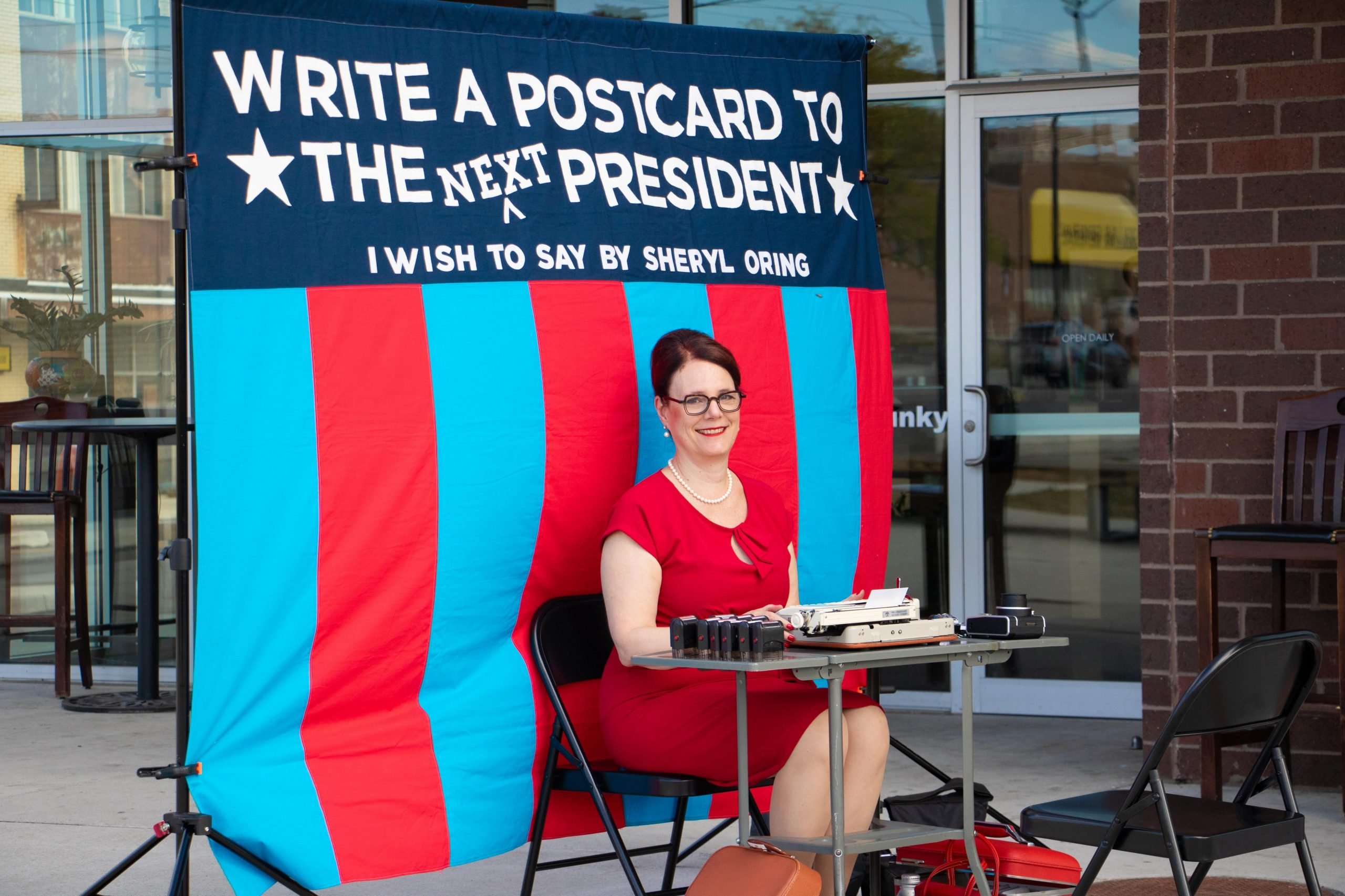
It was a gorgeous fall weekend afternoon, warm and sunny, with a light breeze down at South Street Seaport in New York. But in her makeshift outdoor office, performance artist Sheryl Oring was busy, typing, as she has for over 20 years now, letters from members of the public to the next president of the United States.
“This was my way to lift up the voices of everyday people and give everyone a chance to speak out, regardless of their social status,” Oring told me as she wrapped up the latest day of a project that has seen her type some 4,300 missives since 2004, saving a carbon copy of each letter for her archives.
Armed with a compact vintage typewriter, Oring was dressed in her best 1950s secretary attire, complete with a perfect coiffed beehive hair do. She sat in front of a red and blue striped banner inviting the public to speak their mind—art as a way of engaging in political discourse, capturing the voice of the people, one postcard at a time.
The first iteration of the project, titled “I Wish to Say,” was a commission from the First Amendment Project in Oakland. Though she didn’t have any funding, Oring then took the project on the road for the 2004 election cycle, traveling “on a complete shoestring” to sites including outside the Republican National Convention in New York.
Sheryl Oring, I Wish to Say at Co-Prosperity in Chicago during the Democratic National Convention in August 2024. Photo by Chris Giamo.
Every four years since, the performance has continued, with two national tours courtesy of Creative Capital Foundation grants. In 2016, she was at Bryant Park in New York, enlisting a veritable army of volunteers to man 20 typing stations. In 2020, the project moved to Zoom.
A retrospective of the two decade-long performance is currently on view at New Jersey’s Monmouth University Center for the Arts.
It’s the typewriter that lies at the genesis of Oring’s art practice, which she began while living in Berlin in the late 1990s. Her first major piece, Writer’s Block, is an installation of 650 black vintage typewriters displayed in a series of orange cages. It first went on view in 1999 at the Bebelplatz in Berlin, on the anniversary of the Nazis’ massive book burning there on May 10, 1933.
Sheryl Oring, I Wish to Say. Photo by Chris Giamo.
“I was caging the typewriter, and it’s about taking away the ability to speak,” Oring said. “And then with ‘I Wish to Say,’ it’s like taking the typewriter out of the cage and offering people a chance to speak out.”
In addition to the 650 used in that first project, Oring estimates she has about 150 typewriters in her collection.
“They’re these really beautiful objects. And there’s something very different about typing on a typewriter versus typing on a computer,” she said of the machine’s appeal. “They have a nice sound. They do actually have a smell. The touch of the keys, it’s different for each typewriter.”
A Polaroid of Jovahnnah Skinner and her typewritten letter to the next president, written as part of Sheryl Oring’s performance art piece I Wish to Say. Photo courtesy of the artist.
And the typewriter certainly helps draw in participants curious about the rarely seen analog device, encouraging them to take part in the project.
Over the years, Oring has seen the concerns of letter writers shift. When she started, there were less postcards about gun violence. This election cycle, many people are expressing their concern about war in the Middle East, she told me.
Sheryl Oring performing I Wish to Say during the 2004 Republican National Convention in New York. Photo by Damaso Reyes.
“These letters are kind of a measure of the zeitgeist of the country and whatever’s happening in the world. And so they change based on current conditions,” she said.
Today is the third of three days in New York City, with the artist planning to be in Seward Park Liberty Plaza this morning and Spring Street Park this afternoon. So far, 50 New Yorkers have contributed to the project. Earlier this year, Oring was in Chicago during the Democratic National Convention; Dayton, Ohio; Greensboro, North Carolina; and Alexandria, Virginia. Upcoming stops include Philadelphia, Florida, and California.
A Polaroid of Andrra Ismajli and her typewritten letter to the next president, written as part of Sheryl Oring’s performance art piece I Wish to Say. Photo courtesy of the artist.
“Sometimes the cards are very personal,” Oring said. “Yesterday, in Alexandria, there was a woman who talked about how she had to go back to work two weeks after a c-section. So it was about wanting maternity leave.”
Some people address their postcards to “Madam President,” expressing their confidence that Kamala Harris will win, Oring has found. Others send a more generic message, expressing their hopes for the future of the country to whoever will be chosen to lead it.
“When I first started this project, I did send a postcard,” Oring recalled. “I was writing about how when I was growing up, Geraldine Ferraro was a vice presidential candidate and it had been all these years and we hadn’t had a woman president. I wrote, ‘I hope I’ll see a woman president in my lifetime,’ but that felt so farfetched. Now it finally feels like this actually could happen.”
“I Wish That I Had Spoken Only of It All: 20 Years of Sheryl Oring’s I Wish to Say” is on view at the Monmouth University Center for the Arts, 400 Cedar Avenue, West Long Branch, New Jersey, September 3–December 20, 2024.
Sheryl Oring will be staging her performance I Wish to Say in New York on October 8, 8 a.m.–10 a.m in Seward Park Library Plaza, at East Broadway and Jefferson Street, and 12 p.m.–1:30 p.m. in Spring Street Park, at Sixth Avenue and Spring Streets.